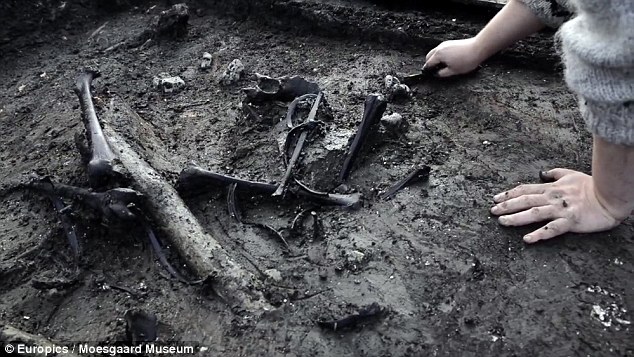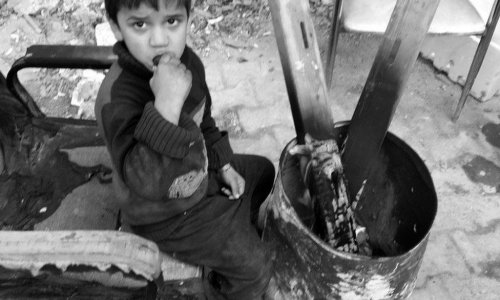A gruesome find in a Danish bog has given archaeologists a glimpse into the mysterious and macabre practices of an Iron Age community.
Experts have found a decapitated human skeleton alongside the remains of dogs that were believed to have been sacrificed as an offering to the gods around 2,000 years ago.
The discovery was made on the same site where a wooden phallus was previously recovered in Skødstrup, north of the city of Aarhus in central Denmark.
The human skeleton, found in a bog in a low-lying area below the remarkably-preserved remains of an Iron Age village, is thought to have been in her twenties when she died.
Her bones were found in a heap, indicating she had been thrown into the bog along with two stakes, one with a sharp point.
Archaeologists from Moesgaard Museum only recovered the jaw from the woman's head, leading them to believe the skull had been separated from the body before it was 'tossed' into the bog.
The bog was originally used for peat cutting in the early Iron Age before seemingly taking on its chilling new role some centuries later.
Since the 1800s, a total of 13 dog skeletons next to tethering stakes, along with a wooden phallus and a trove of weapons including swords, lances and parts of a shield, have also been found in another bog just 492 feet (150 metres) away.
Little is known about the religion that the community practiced, but the archaeologists say that the bodies of humans and dogs were 'clearly sacrificed'.
Moesgaard Museum director Per Mandrup hopes the 'remarkable' find will shed light on religious practices at the time.
He said: 'We expected great things of the excavations because a settlement, a burial ground as well as extensive offerings and sacrifices in the bogs around Skødstrup have previously been found.
'But these new discoveries more than live up to our expectations and the finding of a human skeleton is the crowning touch.'
The Danish find mirrors the discovery of the Lindow Man, whose remains were discovered by workers looking for peat in north-west England in 1984.
Like the young woman found in Denmark, he too had apparently been murdered, possibly as a ritual sacrifice carried out by Druids, having been hit twice in the top of the head with a blunt object.
A cord was similarly tied around his neck before his throat was cut.
His body was then thrown in the bog to complete the ritual.
The similarities between the two cases suggests the sacrifices may have been common practice and were widespread.
Experts hope more evidence of such sacrifices may be found in Denmark as they continue to excavate the site, which also includes the remains of a large village with a cobbled road and preserved house floors.
(CNN)




www.ann.az
Follow us !











